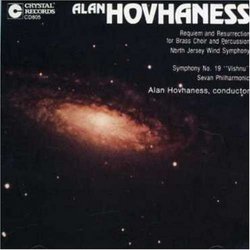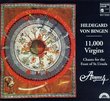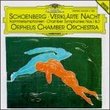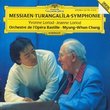| All Artists: Alan Hovhaness, North Jersey Wind Symphony, Sevan Philharmonic Title: Hovhaness: Requiem and Resurrection; Symphony No. 19 "Vishnu" Members Wishing: 1 Total Copies: 0 Label: Crystal Records Release Date: 8/19/1993 Genre: Classical Styles: Chamber Music, Historical Periods, Classical (c.1770-1830), Modern, 20th, & 21st Century, Symphonies Number of Discs: 1 SwapaCD Credits: 1 UPC: 009414780522 |
Search - Alan Hovhaness, North Jersey Wind Symphony, Sevan Philharmonic :: Hovhaness: Requiem and Resurrection; Symphony No. 19 "Vishnu"
 | Alan Hovhaness, North Jersey Wind Symphony, Sevan Philharmonic Hovhaness: Requiem and Resurrection; Symphony No. 19 "Vishnu" Genre: Classical
|
Larger Image |
CD DetailsSimilarly Requested CDs |
CD ReviewsVishnu - Preserver of the Universe Bruce Gray | Shenandoah Valley, VA, USA | 08/12/2003 (4 out of 5 stars) "Here is Hovhaness' most eclectic work. Probably the most free-form type symphony ever to be recorded, "Vishnu" shows off both Hovhaness' fascination with Eastern mythology and stereo systems. From the rumbling of the drums to the clashing cymbals, "Vishnu" is to classical music what Metallica is to Heavy Metal music. This disc starts with the fine "Requiem and Resurrection". Almost all classical composers eventually want to depict the life, death, and resurrection of Christ at some time in their lives, and Hovhaness was no exception. Hovhaness' fascination with Eastern motifs adds an appropriate Middle Eastern flavor to his "Requiem" and his use of brass adds a wonderful boldness to his "Resurrection". Although they are two parts of a single piece of music, it's easy to see where the "Resurrection" begins.But the true gem of this disc lies in Hovaness' own interpretation of his Symphony # 19, "Vishnu". Vishnu is regarded as a major god in Hinduism. He is thought of as the preserver of the universe. Hovhaness returns again to his appropriate Eastern flavor with this symphony, and with Hovhaness at the baton, we will never have a better look at what was desired by the composer."Vishnu" is at once discordant and beautiful. Because of the theme of the preserver of the universe, this switching back and forth, almost as though you could possibly be improvisational with a symphony, adds a luster to this recording that fans of Hovhaness will find lovely, but others may find simply disquieting. It's as though you could see into the mind of a God - having to be everywhere and do everything all at the same time. It's almost a humbling experience.I have always been a supporter of the theory that a symphony is the best form thru which you can find the ideas that flow from a composer's mind. It was only after hearing this recording that I finally made up my mind to attempt to collect all of the major symphonies by Hovhaness (there's 67 in all!) and a greater portion of his lesser works.A fine addition to any collection of Hovhaness' work, and a good addition to a classical music library for homes or classical music stations." Hovhaness - Symphony No. 19 Patrick Gleeson | Limerick Ireland | 06/17/2001 (5 out of 5 stars) "This is quite simply magnificent. Like many others, I came across excerpts of 'Symphony No. 19' on the 'Cosmos' TV series, and for 20 years or so, searched for the piece on record. I eventually found it on CD, was initially taken aback by the sheer breath and scope of this work. The Symphony is in one movement, beginning with a short, almost chaotic assemblage of notes clustered together denoting the birth, death and tumultous life of swirling galaxies. It settles down to a sedate rendering of delightful melodies, which hallmark the strengths of the composer, and alternate between the 'chaos' and melody throughout. Don't for one minute dismiss this as 'difficult' or 'abstract' music. It is neither. Hovaness' gift lies with an innate understanding of the beauty of the musical form.Highly recommended." The Cycles of Creation (No, really!) Thomas F. Bertonneau | Oswego, NY United States | 06/03/2003 (4 out of 5 stars) "Music-lovers seem to be rediscovering Alan Hovhaness (1911 - 2000) thanks, in part, to the advocacy of some youngish conductors - for example, Gerard Schwarz and Vakhtang Jordania. In the 1940s and 50s, Hovhaness enjoyed the good offices of such lights as Leopold Stokowski and Fritz Reiner (as unlikely as that seems) on his behalf. In the 1960s, however, he relied on commissions from regional orchestras and non-stellar music-directors. Then in the 1970s he undertook to make his own case, so to speak, launching his Poseidon label to disseminate recordings of his music, under his own direction, with professional orchestras whenever possible. Works like the "Saint Vartan" Symphony (No. 9, 1948) and "Majnun" (No. 24, 1973) found their way into the black vinyl grooves. The record-sleeves were Spartan: black and white, with the same ink-sketch of a ruined Armenian tower on the cover, and minimal notes on the back. Later, Unicorn licensed some of these recordings and reissued them in packaging more attractive than the original. In recent years, the entire Poseidon catalogue has reappeared on compact disc through the efforts of Peter Christ of Crystal Records, now based in Washington State. It is not impossible that the "Vishnu" Symphony (No. 19, 1966) will be committed again to disc for commercial distribution - but I would not want to bet my paycheck on it. Good it is, therefore, to have Hovhaness' own interpretation of this odd, sometimes frightening, but finally endearing score on compact disc. The composer leads the "Sevan Philharmonic," probably one of the London recording orchestras under a pseudonym, in a convincing performance. "Vishnu," the Hindu god of creation, shows Hovhaness at his most free-form, with extended improvisatory passages in which the strings and trombones compete with each other to make nerve-wracking glissandi. The Symphony begins with strange ululations in the brass, culminating in wild flourishes from the trumpets, followed by the "spirit murmur" and a cascade of bells and chimes. Hovhaness then freely repeats and combines these elements. The idea is of cosmic creations by the divine entity, who fancifully spins out galaxies and nebulas. Some passages are apparently improvised under the conductor's direction. Thus the flutes weave micro-tonally inflected "organum" over a background of plucked strings and occasional highlights from the glockenspiel. "Vishnu" has no noticeable form, but this is not an objection to it as music. Although written earlier, it is rather like the chamber symphony called "Mountains and Rivers without End" (1972) on a larger scale. The dissonances, when they occur, are only for effect and pass swiftly. Otherwise Hovhaness treats us to his Central-Asian inflected chorales and processions. Possibly only Hovhaness could have pulled it off. The notes speak of a drastically cut and unsatisfying premiere under Andre Kostelanetz - who, to his credit, did make the first recording of another Hovhaness score, "And God Created Great Whales." The accompanying item, which actually comes first on the program, is the "Requiem and Resurrection" for Brass Choir and Percussion (1967). I would rate this as one of Hovhaness' most effect - because cogent - works; it is on par with the "Fra Angelico" Fantasy for Full Orchestra (1968), and is on the same scale, requiring about fifteen minutes for performance. The title tells us what to expect: six or seven or minutes of mournful obsequy, followed by an equal measure of celebratory music in quasi-major, rather than in minor, modes. Hovhaness always wrote to advantage when he had the brass instruments in mind because his melodic line naturally follows vocal contours that sound quite graceful when given to the trumpet, the horn, or the trombone. "Requiem and Resurrection" makes wonderful late-night listening. Is the music Armenian, Himalayan, Japanese, Chinese? Who knows? It comes from the land of the composer's imagination, where pious people of a pre-modern dispensation gives thanks to the supernatural and revere the saints and holy men. Be young again. Give it a try..."
|

 Track Listings (2) - Disc #1
Track Listings (2) - Disc #1








